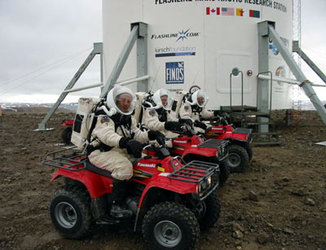Postcard from Mars 2
Over the next two weeks, ESA physicist-engineer Vladimir Pletser, who develops ISS payloads and organizes zero-gravity parabolic flights for the Agency, is on his second mission to Mars.
Well, not exactly Mars, but his two weeks in a habitat in the desert of Utah are as close as anyone is going to get for now.
The habitat in Utah is the second of four built by the Mars Society with private international funds. Last summer Vladimir spent 10 days at the first Mars habitat on Devon Island in Canada's Nunavut territory. Over the next couple of years, a further two habitats will be built in Iceland and in the Australian outback.

It is hoped that the Mars habitats will teach us whether a manned mission to the Sun’s fourth planet is feasible, and what it would be like to live there ourselves. During the first simulation some crews found they could get by on less water than the previously estimated 45 litres per day per person. This is a significant finding since the amount of water needed has a huge effect on the mass and cost of the mission.
Six crew members will in turn spend two weeks in the Martian habitat in Utah, conducting field experiments in geology, geophysics and biology during simulated EVAs. Vladimir will be responsible for a simple experiment to assess the psychological aspects of growing food in the habitat and in the base greenhouse.
Over the next couple of weeks Vladimir Pletser will be keeping a diary of his mission. Each day the latest update will be posted on this web site.















 Germany
Germany
 Austria
Austria
 Belgium
Belgium
 Denmark
Denmark
 Spain
Spain
 Estonia
Estonia
 Finland
Finland
 France
France
 Greece
Greece
 Hungary
Hungary
 Ireland
Ireland
 Italy
Italy
 Luxembourg
Luxembourg
 Norway
Norway
 The Netherlands
The Netherlands
 Poland
Poland
 Portugal
Portugal
 Czechia
Czechia
 Romania
Romania
 United Kingdom
United Kingdom
 Slovenia
Slovenia
 Sweden
Sweden
 Switzerland
Switzerland




























